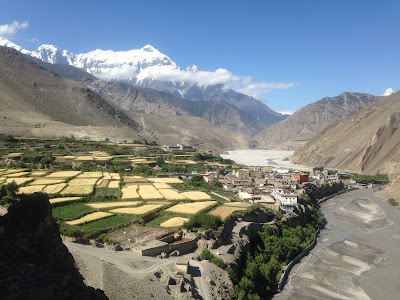Lumbini Circuit Tour
Lumbini
Circuit Tour
Lumbini
the holy birthplace of Lord Buddha and a famous pilgrimage for
millions of Buddhists all over the
world. Situated 22km., west of
Siddharthangar, is also famous from
tourist cultural and archeological view points. Ashokan pillar, Mayadevi temple
, jativity sculpture,eternal peace
flame, many Buddhist temples, stupas,
viharas, monasteries build by different counters, Lumbini international
research institute etc. Are unique sites in Lumbini, strolling around th scrod garden provides heavenly pleasure.
It is a pilgrimage site for all who cherish peace and harmony and are
encouraged to undertake spiritual journey.
TILAURAKOT:-
The ancient capital of Sakya, Kapilvastu, has now been identified with Tilaurakot, a site in ruins located 25 km west of Lumbini. The five periods of habitation of this walled city begin from 8th - 7h B.C. and end in 2 d century A.D. Excavations have revealed the foundations of a citadel with defence wall, gateways, monasteries and stupas. KUDAN :-
Is located 2-km southwest of Taulihawa on way to Gotihawa. There are huge structural ruins indicating wreckage of monasteries and stupas with a tank nearby.
The ancient capital of Sakya, Kapilvastu, has now been identified with Tilaurakot, a site in ruins located 25 km west of Lumbini. The five periods of habitation of this walled city begin from 8th - 7h B.C. and end in 2 d century A.D. Excavations have revealed the foundations of a citadel with defence wall, gateways, monasteries and stupas. KUDAN :-
Is located 2-km southwest of Taulihawa on way to Gotihawa. There are huge structural ruins indicating wreckage of monasteries and stupas with a tank nearby.
GOTIHAWA
: -
Lies 5-km southwest of Taulihawa town and is considered the natal town of Krakuchanda Buddha. The place has ruins of ancient habitation, stupas and monasteries. The place was visited by Ashoka as evidenced by a pillar with inscriptions. The pillar is broken with the upper part missing.
Lies 5-km southwest of Taulihawa town and is considered the natal town of Krakuchanda Buddha. The place has ruins of ancient habitation, stupas and monasteries. The place was visited by Ashoka as evidenced by a pillar with inscriptions. The pillar is broken with the upper part missing.
ARAURAKOT:-
Lies about 9-km northeast of Tilaurakot. P.C. Mukheiji (1899) identified it as the natal town of Kanakmuni Buddha. It is a rectangular fortified area that contains a moat with heaps of ancient ruins.
Lies about 9-km northeast of Tilaurakot. P.C. Mukheiji (1899) identified it as the natal town of Kanakmuni Buddha. It is a rectangular fortified area that contains a moat with heaps of ancient ruins.
NIGLIHAWA
:-
7-km northwest of Tilaurakot, was another site visited by Ashoka and marked with a pillar. The pillar is broken into two pieces. The standing base pillar has Ashokan inscription in Brahmi script and the upper pillar has Devanagari* inscription marking Ripu MaiWs visit in 1312 AD. There are ruins of monasteries, stupas and
7-km northwest of Tilaurakot, was another site visited by Ashoka and marked with a pillar. The pillar is broken into two pieces. The standing base pillar has Ashokan inscription in Brahmi script and the upper pillar has Devanagari* inscription marking Ripu MaiWs visit in 1312 AD. There are ruins of monasteries, stupas and
SAGARHAWA
:-
L lies 3.5 kin. north of Tilaurakot and west of Banganga river. It is a rectangular depression. Excavations done in 1896 traced seventeen stupas and large monuments made from well-burnt bricks. Findings of casket and other rare antiquities indicate them to be votive stupas of the war dead. However, these stupas remain no more as they were excavated to their foundation without restoration. habitation. It is identified as ancient town of Sobhawati, birthplace of Kanakmuni Buddha.
L lies 3.5 kin. north of Tilaurakot and west of Banganga river. It is a rectangular depression. Excavations done in 1896 traced seventeen stupas and large monuments made from well-burnt bricks. Findings of casket and other rare antiquities indicate them to be votive stupas of the war dead. However, these stupas remain no more as they were excavated to their foundation without restoration. habitation. It is identified as ancient town of Sobhawati, birthplace of Kanakmuni Buddha.
DEVDAHA:-
L lies 34-km northeast of Lumbini near the village of Khairhani. The Koliya of Devadaha are considered as maternal tribe of Gautam Buddha. There are archaeological mounds near the village.
L lies 34-km northeast of Lumbini near the village of Khairhani. The Koliya of Devadaha are considered as maternal tribe of Gautam Buddha. There are archaeological mounds near the village.
RAMGRAM
:-
Lies 4 km south of Parasi town in Nawalparasi district. The remains of stupa and monastery as mounds are beside the bank of Jahari river in Kerwani village. The huge stupa mound is 30 ft high and 70 ft. in diameter. Koliyas of Ramagram are listed among the eight tribes that received the corporeal relics of the Buddha at Kushinagar.
Lies 4 km south of Parasi town in Nawalparasi district. The remains of stupa and monastery as mounds are beside the bank of Jahari river in Kerwani village. The huge stupa mound is 30 ft high and 70 ft. in diameter. Koliyas of Ramagram are listed among the eight tribes that received the corporeal relics of the Buddha at Kushinagar.



Comments
Post a Comment